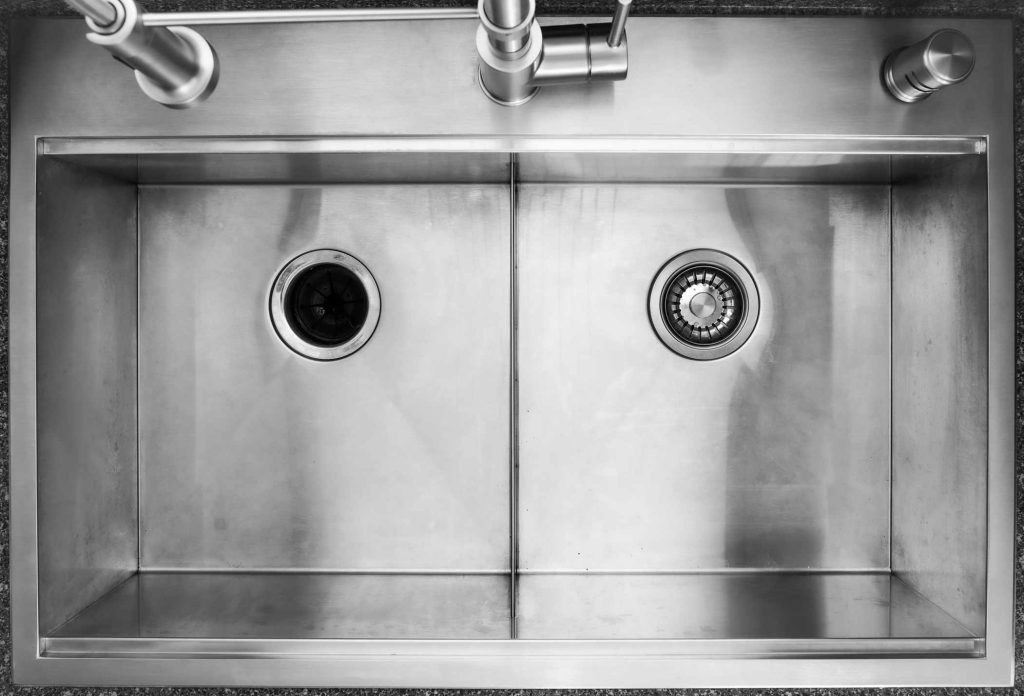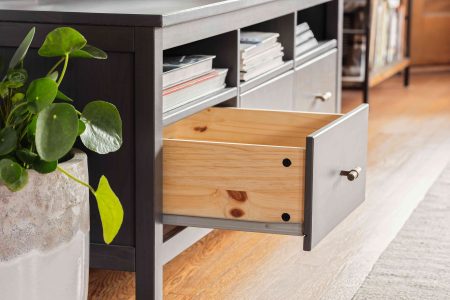A clogged kitchen sink is common. But when it’s a double kitchen sink with a garbage disposal on one side, it’s a little more complicated. One side has a garbage disposal and the other side doesn’t, yet both sides share the same P-trap assembly below. With a few simple steps, though, it’s simple to narrow down the location of the clog and fix it.
Before You Begin
Before you begin, read the chart below to determine the cause of your clog and how to fix it:
| Condition | Causes | Solutions |
| Clogged on disposal side | Disposal isn’t working or is clogged or jammed | Disposal must be reset or its power turned back on. Clogs can be plunged out and obstructions must be forced through or removed |
| Clogged on non-disposal side | Pipe directly below sink is clogged | Plunge with a cup-style drain/sink plunger |
| Clogged on both sides | Clog in P-trap or farther down drain line | Remove and clear P-trap; snake drain line |
When Either Side Is Clogged
If water on the disposal side of the sink is moving slowly or not at all, the first thing is to check if the disposal is working. The disposal may need to be reset or its power turned back on. If the disposal is working but is jammed, obstructions must be forced through or pulled out.
If water on the non-disposal side is blocked or slowly moving, the short tailpiece that leads to the trap is usually clogged. The tailpiece can be unclogged by plunging it with a cup-style drain/sink plunger.
When Both Sides Are Clogged
When both sides of a double kitchen sink are clogged, water may initially exit one drain but will rise on the other side. Then, the water will rise on both sides. The problem is usually a clog in the P-trap pipe assembly below the sink or farther down the line.
The P-trap can be removed, cleaned, and replaced. If necessary, the drain pipes past the P-trap can be cleaned out with a drain snake (or drain auger), which typically extends up to 25 feet down the line.
Safety Considerations
Be cautious when working with garbage disposals to avoid electric shock or injury from the impellers (blades) or from any moving parts on the garbage disposal.
Unplug the garbage disposal from the wall outlet below the kitchen sink. Not all garbage disposals are cord-connected. For garbage disposals permanently connected to a wiring system (hard-wired), turn off the circuit breaker that controls the outlet. The circuit breaker can be found on the electric service panel.
Never place your fingers in the hopper chamber since the impellers can be sharp enough to lacerate fingers even when they aren’t moving.
What You’ll Need
Equipment / Tools
- Drain and sink plunger
- Garbage disposal stopper
- Garbage disposal wrench accessory or Allen wrench set
- Flashlight
- Wooden spoons
Materials
- P-trap assembly (if needed)
- Tailpipe extension tube (if needed)
Instructions
How to Fix a Clog On the Disposal Side
-
Check the Power Source
Check the electric service panel for a tripped circuit breaker or a blown fuse. Press the small reset button, usually located on the bottom of the disposal and try running the disposal.
-
Unplug the Disposal
In the kitchen base cabinet under the sink, unplug the garbage disposal. Verify that the disposal has no power by trying to turn it on.
-
Clear Small Obstructions
For small obstructions that can be flushed away, unjam the garbage disposal with the garbage disposal accessory wrench that came with the unit. If the wrench has been lost, use a 1/4-inch hex-style Allen wrench. Turn the tool back and forth to dislodge the obstruction. Then, make one full turn with the wrench.
-
Remove Large Obstructions
With the garbage disposal unplugged, look into the disposal from above with a flashlight to check for obstructions. For large obstructions that need to be removed, use kitchen tongs, handles of wooden spoons, or chopsticks.
-
Block the Non-Disposal Side
Block the non-disposal side of the sink with the disposal stopper. A disposal stopper is a round, solid plastic or metal drain plug, usually with a handle on top.
-
Plunge the Disposal Side
Holding the stopper in place with one hand, use the other hand to plunge the disposal side of the sink. It helps to first remove the splash guard.
Fix a Clog On the Non-Disposal Side
-
Block the Disposal Side
Block the drain on the disposal side with the disposal stopper. Do not put your hands in the drain.
-
Plunge the Non-Disposal Side
Holding the stopper on the disposal side of the sink, use the plunger with the other hand to plunge the non-disposal side.
Fix a Clog On Both Sides
-
Remove the P-Trap
Clear items from the kitchen cabinet below the sink. Place a low-sided bucket below the P-trap. By hand, unscrew the P-trap from three places: the sink drain, the straight pipe leading from the garbage disposal, and the straight pipe leading into the wall. Let water drain into the bucket.
-
Clean the P-Trap
Remove the P-trap. Rinse out the P-trap elsewhere to remove obstructions. You can disassemble the P-trap for easier access when cleaning.
-
Replace the P-Trap
If the P-trap’s pipes were blocked, likely this was the cause of the clogged drain, so the trap can be replaced. For excessively oily or greasy pipes, this may be a good time to purchase and install a new P-trap.
-
Snake the Drain
If the P-trap was not obstructed, the blockage may be farther downline. Snaking the drain can often retrieve and remove the obstruction.
- Leave the P-trap off. Replacing the P-trap only adds unnecessary curves and length for the drain snake to travel.
- Loosen the thumbscrew on the drain snake drum.
- By hand, extend the snake into the drain as far as it will go without rotating.
- Tighten the thumbscrew.
- Slowly rotate the drain snake clockwise several times.
- Loosen the thumbscrew.
- Pull the drain snake cable straight back to you.
- Clean off the drain snake cable and spiral-shaped auger head.
- Repeat the process until you have gone as far as the snake will permit.
When to Call a Professional
If none of these methods work, it’s time to call a licensed plumber. A plumber may need to replace the garbage disposal if the unit is faulty. A plumber can also help you snake the drain for the entire route, from the house to the municipal sewer main.
Plumbing companies equipped with sewer video scopes and locator units can help you see what might be blocking the drain lines.
Read the full article here









